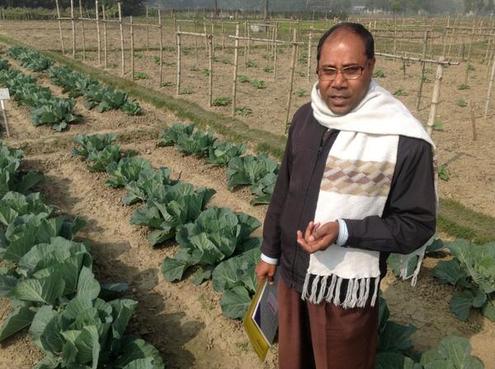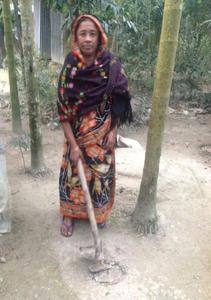A sanitation project's work is not finished with the installation of a pit latrine. What happens a year or two later, when the latrine is full?
Published on: 19/03/2013
The BRAC WASH programme first set out to understand what people do with their excreta when their latrines fill up. BRAC surveyed 208 randomly selected households, and found that 11% dumped the contents in the open. This undermines the point of having the latrine; in these cases, the latrine hasn’t prevented open defecation, just postponed it.
The most common response to a full latrine – practised by 58% of households – was to bury the excreta, either leaving it in the pit if the household has a double pit latrine, or digging a separate hole. But simply burying the excreta could be wasting a valuable resource.
BRAC has been researching the potential to create a market for human manure as fertiliser. The job of emptying pit latrines – currently stigmatised in Bangladeshi society – could become an entrepreneurial opportunity to “turn shit into gold”, in the words of the Water Supply and Sanitation Collaborative Council’s campaign to link “Good Dignity Practices” with “Gross Domestic Product”.
There are cultural and religious taboos in Bangladesh around the practice of fertilising crops with human waste, yet the practice is well known in rural areas – just not openly discussed or admitted.
BRAC found that there are two problems to overcome. First, there are cultural and religious taboos in Bangladesh around the practice of fertilising crops with human waste. According to one earlier study of attitudes, most people showed discomfort when asked about it, and only a few hesitantly expressed support. Fewer than 5% of the households surveyed by BRAC said they had used their excreta as fertiliser.
Nonetheless, a feasibility study by BRAC’s marketing team found that the practice is well known in rural areas, just not openly discussed or admitted. Research into how farmers currently use fertiliser suggests there is a great deal of potential to increase the productive use of faecal sludge, if attitudes can be changed. One possible part of the way forward is rebranding. Instead of referring to the contents of full latrines as excreta, or faecal sludge, or human manure, how about calling it…“brown gold”?
To win people over, it will also be essential to demonstrate conclusively the safety of the practice. Which brings us to problem number two.
BRAC’s research showed that Bangladeshis who admit to using faecal sludge as manure believe that it is safe if composted for a year. When BRAC tested the content of double pit latrines that had not been used for 12 months, however, it found that the sludge still contained dangerous levels of eggs of worm-like parasites called helminths.
Researchers of BRAC WASH programmes are hard at work on finding treatments that kill off the helminths. It is imperative that the techniques eventually developed are “cheap and simple”, in the words of Dr Elisabeth Kvarnström. Possibilities currently being investigated include urea treatment, sun drying and high-temperature composting.
BRAC and IRC are also tendering a call for action research on how to treat manure from single pit latrines. BRAC WASH favours double pit latrines, as sludge can be left to compost in the first full pit while the second is used. However, there are an estimated two million single pit latrines in Bangladesh, so it is worth seeking ways of making their contents useable, too.
As well as working to establish how the excreta can be made safe for fertiliser use, BRAC’s researchers are in the process of documenting its effectiveness. In the fields outside the research centre, rows of rice and cabbages treated with faecal sludge are growing alongside control crops treated with chemical fertiliser and with cow dung in the laboratory of the BRAC Agriculture Research and Development Centre in Gazipur, an hour north of Dhaka. Results are expected later in 2013.

In the laboratory, the nutrients available in samples taken from pit latrines across seven different ecological zones in Bangladesh are being analysed, and matched against the nutrient requirement of different crops. Understanding the most effective uses of the fertiliser should ultimately help with its marketing.
A solid evidence base will be needed to overcome the initial scepticism that will inevitably greet any large-scale attempt to bring “brown gold” onto the market. Companies that market existing fertilisers are likely to resist – although there is an important potential ally in the shape of the Bangladeshi government, which heavily subsidises fertilisers and could make considerable savings if faecal sludge were widely adopted.
Once the researchers are satisfied that the sludge can be made safe and profitable, BRAC plans a pilot project to train micro-entrepreneurs in emptying latrines, treating the sludge and selling it to farmers. If successful, it could be scaled up.
The quest to find profitable outlets for human excreta promises wins on multiple fronts.
In parallel, BRAC and IRC are studying the feasibility of setting up a commercially viable biogas factory. Likely to require investment of about €3 million, it would combine inputs from pit latrines with agricultural waste to produce fertiliser on a much larger scale, along with compressed natural gas (CNG) which can be used to fill up cars. This is something that has been piloted in Sweden and Germany.
The quest to find profitable outlets for human excreta promises wins on multiple fronts: an environmentally friendly source of power; improved crop yields at lower cost; a source of income for households; and an incentive for everyone not only to install pit latrines, but also to dispose safely of their contents when they are full.

Although not often openly discussed, use of human excreta as manure is far from being an unknown practice in rural Bangladesh. In Kazircup village, Shahrasti Upazila (sub-district), Chandpur, Mrs Zulekha Begum explains that she and her husband had filled the first pit of their double pit latrine after 18 months. They put a lid on it and switched to using the second pit. After a year, she says, they lifted the lid off the first pit, emptied the contents – now dry and odourless – and put it on their fruit trees, which subsequently produced well. Even year-old sludge can contain dangerous levels of helminths, however; BRAC is currently working on treatment options.
Sharmin Farhat Ubaid, BRAC WASH, Dick de Jong, H2O Communications, Andrew Wright and Joep Verhagen, IRC
February 2013
At IRC we have strong opinions and we value honest and frank discussion, so you won't be surprised to hear that not all the opinions on this site represent our official policy.